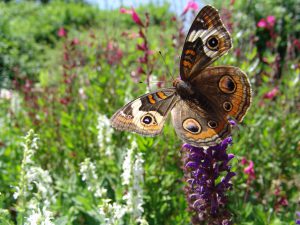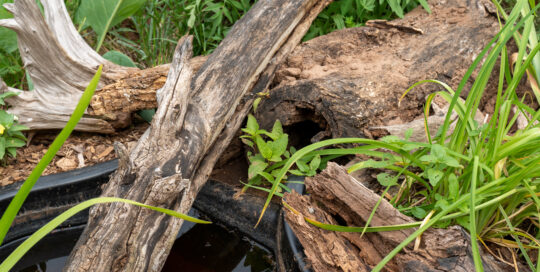Composting and the Invasion of Evil Alien Earthworms
Views: 4951

This is my first blog, so I thought I’d start with a brief introduction. I live on 3.5 acres just outside the city limits of Stillwater, Oklahoma, with my spouse, two cats, two dogs, and six backyard chickens and many many earthworms.
After purchasing our property, we removed over 150 cedar trees. Firefighters refer to Eastern Red Cedars (Juniperus virginiana) as “gasoline on a stick,” and we needed to reduce the fire hazard to our house. Wildfires are not infrequent in Oklahoma, especially during years of drought. This also opened up our front and back yards to some sunlight, allowing for more diverse plantings and gardens.
SunDog House
We call our house “SunDog House,” because I’ve always thought that homes with personalities should have names. And SunDog House has a unique personality. Our property borders a large, shared pond, and we have a wooded ravine that backs up against the pond’s dam. The ravine is damp, being fed from a small spring. When the pond overflows, we get a lovely waterfall. SunDog House is good habitat for wildlife because we have sunny, grassy spaces at the top of the yard, wet woods in the back, plus access to a large body of water.
I have seen almost every species of butterfly to be found in this part of Oklahoma in my yard. We also have many birds. We have deer, fox, squirrels, rabbits, raccoons, possums, skunks, armadillos, moles, lizards, tree frogs, toads, snakes, coyotes, and many other animals who share our little plot of land.
The Gardens
I do not have perfectly manicured gardens, and I have a high tolerance for chaos, weeds, brush piles, dead trees, and pests like gophers that might drive other gardeners mad. If something might benefit wildlife, I’m very likely to leave it be. Though, I still feed my plants. I prefer planting natives, although I don’t do so exclusively. Most things in my yard have some heat and drought tolerance. While I may not be a stop on the spring garden tour, I don’t need to leave my yard to have a spectacular day birding and photographing butterflies.
But, let’s face it, the real reason you’re here is because you want to learn about the invasion of evil alien worms, right? Right. It’s a tongue-in-cheek title, but it has a serious issue behind it.
The Evil Comes
Most of Canada and northern parts of the United States have no native earthworms. The theory is that glaciers in the last ice age either killed them off. Either that or they prevented any earthworms from becoming established in those areas. If you live on property that was once covered by a glacier, chances are that the earthworms you have in your soil originated from Europe or Asia.
Now, earthworms are beloved by gardeners because they break down organic matter and detritus, creating rich, healthy soil. Earthworms improve nutrient availability, drainage, and soil structure. There are many reasons we love them. So why does it matter if earthworms are foreign or native?
Forests that evolved without earthworms have a rich understory. Layers of leaf litter provide food and shelter for diverse plant and animal species. Without earthworms, this leaf litter is not broken down quickly. This forms a spongy mat of nutrient-rich organic matter feeding everything from ferns to baby trees.
Alien Earthworms
When alien earthworms become established in a forest, they do what earthworms do: destroy the leaf litter and dead plant material on the forest floor. This, in turn, reduces the quantity and diversity of plant life in the forest. Unfortunately, some of the most destructive species are not even native to North America. It’s a double whammy of sorts: Earthworms don’t belong in our northern forests, but the most destructive culprits don’t even belong on this continent.
For me, the most heartbreaking side effect of the evil alien earthworms’ invasion is this: Studies have shown that changes to the forest floor are having an adverse effect on ground-nesting birds such as Ovenbirds and Hermit Thrushes. These birds camouflage their nests from predators. When the diversity and density of plant life is destroyed, these birds’ nests become much more visible, enabling predators to find them and eat the eggs or baby birds. So, alien earthworms equate to fewer beautiful songbirds in our forests and gardens. If you’ve ever heard a thrush singing in spring, you’ll understand why I consider this to be a terrible loss. (This website lets you listen to a Hermit Thrush song: //www.allaboutbirds.org/guide/Hermit_Thrush/sounds).
Where did they come from?
Alien earthworms may first have arrived in North America with colonists from Europe. However, in many northern locations, their distribution pattern is tied to large bodies of water and roads, possibly tracing back to their use as fishing bait. These foreign earthworms are marketed to fishermen as “night crawlers,” “leaf worms,” “Canadian crawlers,” “Jumping Worms,” or “Angle Worms.” They spread slowly but are nearly impossible to eliminate. The State of Minnesota has even passed legislation making it illegal to dump fishing bait on the ground or in the water, in an effort to combat the problem.
However, there are concerns that some of these worm invaders may come from garden composting. Some of the most destructive species, Red Wigglers/Red Worms (Lumbricus rubellus) and Jumping Worms from the genus Amynthas, are marketed for vermicomposting. Sure, they’ll do a great job breaking down your compost, but they’ll also do a great job breaking down that lush mat of leaf litter on a forest floor.
While having alien earthworms escape into the environment in an urban area is probably relatively harmless since that land is already extremely disturbed, if you garden out in the country, especially in wooded areas, please use species that are probably safe, or at least safer, such as Eisenia Fetida and Eisenia Andrei. Keep them contained. You may forever alter the composition and life cycle of your woods if you aren’t careful.
For more information, or if you’d just like to see some pictures of forests with and without alien earthworms, check out these resources:
- Information from the Great Lakes Worm Watch: http://greatlakeswormwatch.org/forest/index.html
- A brochure from the Minnesota Department of Natural Resources: http://www.dnr.state.mn.us/invasives/terrestrialanimals/earthworms/index.html
- An information sheet about Crazy Worms (Amynthas agrestis): http://marquette.uwex.edu/files/2014/06/Crazy-worms-fact-sheet.pdf
Meet Leslie Miller
Leslie Ann Miller shares 3.5 acres in rural Oklahoma with birds, butterflies and wide variety of animals. She is currently transforming her yard with plantings…
Leslie's Recent Posts

Creating microclimates and microhabitats to benefit wildlife






